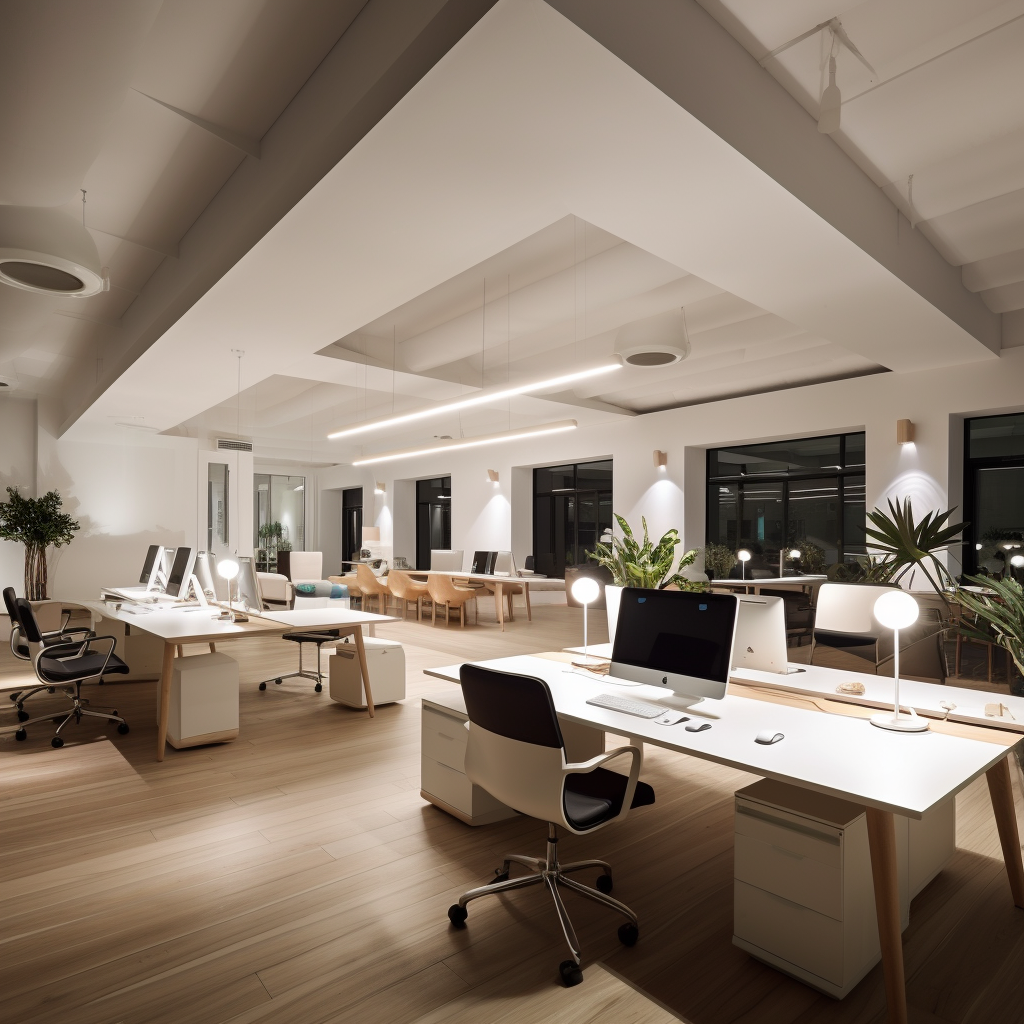Lighting plays a critical role in shaping our work environment.
With its customizable spectrum and intensity, LED lighting can create an optimal work atmosphere that fosters concentration and efficiency.
But how can you use LED lighting in the workplace to positively impact employee performance and safety?
Let's take a look!
The effects of LED lighting in the workplace explained
LED lighting in the workplace is more than just a trend, but a strategic move that pays dividends in creating a healthier and more productive workspace.
This innovative lighting solution, which has been rapidly adopted by forward-thinking organizations worldwide, harnesses the power of modern technology to illuminate workspaces in ways traditional lighting can't match.
But while there are, clearly, benefits of LED lighting, it's prudent to focus on any downsides, too.
Positive effects of LED lighting in the workplace
There's more to LED lighting than its energy efficiency — it holds the potential to transform your workplace environment entirely.
By understanding these benefits, you'll see how making the switch can be a strategic decision that enhances employee satisfaction, productivity, and your bottom line. Let's explore these benefits in detail:
Reduces sick leave
Poor office lighting is often linked to an increase in headaches, eye strain, and fatigue among employees, all of which can eventually lead to more sick days. Replacing conventional lighting with LED lighting can significantly alleviate these symptoms.
A study conducted by the American Society of Interior Designers confirmed that the right quality and intensity of light can reduce fatigue and increase overall employee wellness. While the study does not mention LED lighting specifically, it emphasized the importance of adequate lighting for employee health and well-being.
Also, circadian lighting is a good application for LED lighting where it supports the body's natural rhythm to promote better sleep quality, reducing stress levels and improving overall health.
This can be done by adjusting the color temperature and intensity of LED lights throughout the day to mimic natural light patterns.
Additional reading: mall lighting
Boosts employee engagement and morale
The Human Spaces report found that natural light and well-lit spaces boost morale and productivity levels in employees. They found that people working in offices with natural elements, such as sunlight and greenery, were 6% to 15% more productive.
While LED lighting isn't natural light, certain types can mimic natural light and create a more vibrant working environment. This can help uplift an employee's mood and promote a more collaborative and motivated workforce.
This benefit also extends to retail lighting and convenience store LED lighting where customer experience is crucial for business success.
Additional reading: LED factory lighting

Enhances employee mood and comfort
A well-illuminated workspace with optimal lighting levels can help mitigate mood swings and discomfort associated with dim or overly bright lights.
The ability of LED lights to mimic natural light has been shown to improve mood and satisfaction among workers. This is echoed in a study by the Lighting Research Center, which found that tailoring light exposure to individual needs can lead to better sleep and improved mood.
Again, while the study did not mention LED lighting specifically in this context, it emphasized the importance of light customization and personalization for employee well-being. This is something that is certainly possible with LED lighting, as it offers a wide range of color temperatures and intensity options.
By switching to LED lighting, businesses can create a workspace that not only promotes the well-being and comfort of their employees but also contributes to a more productive and harmonious working environment.
Advances perception and cognition
LED lighting systems are of particular relevance in industries where visual accuracy and cognitive efficiency are key to optimal performance.
According to a lighting study examining industrial applications, LED lighting, particularly those with higher color temperatures, showed significantly improved visual acuity in tasks involving symbol identification and color recognition compared to fluorescent lighting.
Additionally, LED lighting led to reduced fatigue ratings among volunteers, contributing to faster response times on tasks that require spatial and verbal memory.
This indicates that LED lighting can enhance alertness and overall cognitive efficiency among workers when compared to traditional alternatives.
Increased Safety
According to a comprehensive study published in the Sustainability Journal, LED lighting increases visibility, thereby reducing risks of accidents and mishaps.
The research highlights that LED lights produce a higher quality light that offers better color rendering and visibility compared to traditional lighting sources. This enhanced visibility allows employees to identify and navigate potential hazards more efficiently, thereby promoting safer working conditions.
For example, factory LED lighting systems can be customized to provide high-intensity lighting in specific zones, such as assembly lines or storage areas, while reducing the intensity in areas that require less visual acuity.
This feature not only ensures employee safety but also contributes to energy and cost savings.
Likewise, LED lighting for warehouses or parking lots can be programmed to provide motion-activated lighting, reducing energy consumption and increasing safety by eliminating dark areas that may pose potential hazards.
Negative effects of LED lighting in the workplace
Despite the myriad of benefits, it's essential to also consider potential negative effects of LED lighting in the workplace. However, it's important to note that these issues are often not inherent problems with LED lighting itself but arise from misuse or poor installation procedures.
Eye Strain and discomfort
According to the American Optometric Association, prolonged exposure to high-intensity LED light can cause visual discomfort or "digital eye strain". Symptoms can include dry eyes, headaches, and blurred vision.
This effect can be particularly pronounced if the lighting is overly bright, poorly directed, or if it results in glare on screens or reflective surfaces.
Disruptions to sleep patterns
A comprehensive study published in the Journal of Clinical Endocrinology & Metabolism found that light exposure at night, particularly blue light, can interfere with the body's production of melatonin, a hormone that controls sleep-wake cycles.
But while the study does not mention LED specifically, it is important to note that many LED lights emit high levels of blue light. Therefore, we can infer that prolonged exposure to LED lighting late into the evening may have a similar effect on melatonin production and, in turn, disrupt sleep patterns.
Improper color temperature
As per a study published in Journal of Environmental Psychology, the color temperature of lighting significantly influences human's mood and cognitive performance:
- Too warm: may induce relaxation but can decrease concentration
- Too cold: could increase alertness but may also result in discomfort over time.
To avoid this issue, choose LED lighting with the right color temperature and color rendering index for the task or environment.
For instance, cooler color temperatures (5,000K) work well for task lighting in offices, while warmer color temperatures (3,000K) are better for general ambient lighting.
Looking for LED lighting solutions for working environments?
At FES Lighting, we're committed to providing energy-efficient lighting solutions that not only enhance workplace productivity but also prioritize employee health and safety.
Our unique lighting as a service business model ensures seamless and hassle-free integration of LED technology into your workspace. No upfront costs, no installation worries, and we handle all the maintenance. Your workspace gets the lighting upgrade it deserves, and you get peace of mind knowing that we've got your back.
But how can you be sure you need a lighting upgrade? We've also got you covered with our comprehensive energy audit checklist for commercial buildings. This checklist will guide you to identify areas of energy inefficiency, calculate potential savings, and make an informed decision on whether a lighting upgrade is the right move for your business.
We likewise cater to government lighting projects through our GSA Schedule contract, providing even more options for LED lighting solutions in the workplace.
So, take the first step to enhance energy efficiency, reduce costs, and improve employee wellbeing.
Contact us today for a consultation and see the difference our LED commercial lighting solutions can make in your workplace!


%20(1).png?width=1080&height=1080&name=FES-Ebook-1%20(1)%20(1).png)